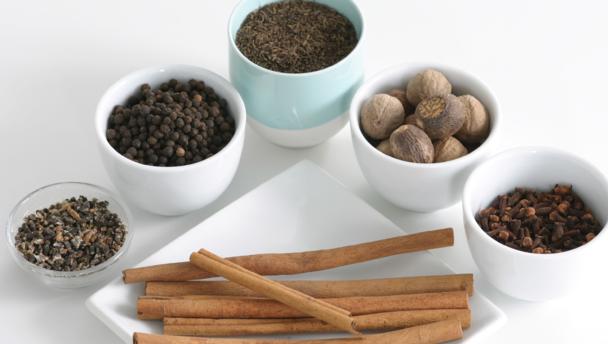

Spices have always been valued for their ability to add flavour, colour and aroma to dishes, but before the advent of refrigeration they were also an important means of food preservation, and in some cultures their medicinal and antiseptic characteristics are revered. The regional cuisines of India, Thailand, Indonesia and Malaysia rely a great deal on spices. Spice mixes are important in these countries, but will often be in fresh paste form rather than the dried spice mixes found in the UK.
 Piri-piri prawns and harissa couscous
Piri-piri prawns and harissa couscous
 Paneer and vegetable skewers
Paneer and vegetable skewers
Buy spices from an ethnic grocer rather than a supermarket: prices are surprisingly low and quality is top-notch. Good brands of spices will have a strong aroma and the packets will be free of dust and other debris. The aroma and colour of ready-ground spices can quickly fade; many experts insist that the best flavour comes from toasting and grinding whole spices yourself just prior to cooking.
Some of the authentic ingredients of South East Asian cuisine, such as galangal (a member of the ginger family) or Thai red and green curry pastes, may need to be tracked down at specialist retailers, but other typical ingredients such as fresh chillies, lemongrass, garlic and ginger are readily available in supermarkets. In South East Asia, many households rely on convenient ready-made curry pastes purchased at the local market, so you should not hesitate to use them, especially authentic brands from specialist stores.
Spices are at their best when used within three months of purchase. Kept in an airtight container away from direct sunlight and heat, dried whole spices will keep for about 12 months, and dried ground spices for about six. To ensure maximum freshness, buy whole spices rather than powders, and grind only what you need. Glass jars may be commonplace but the traditional metal Indian spice box is better because it keeps the spices dark and cool. Some experts recommend storing ground spices in a plastic container in the refrigerator.
It's a good idea to have a clean out at the same time every year and replace any old packages of spices with new ones. It's also better to buy small amounts frequently than to buy bulk bags that will take you a long time to get through.
Toasting spices enhances their aroma and makes them easier to grind. Some people also believe it makes the spices more digestible. To toast or dry-fry spices, heat a griddle over a moderate heat, add the spices, and shake the pan until the spices give off a warm, nutty aroma - it doesn't take long, about 30 seconds. As soon as the spices are fragrant they should be transferred to a mortar (or spice grinder, coffee mill, or food processor with the milling attachment) and allowed to cool before being ground. Dropping whole spices into a spoon of hot oil will also release their essential oils.
Type the ingredients you want to use, then click Go. For better results you can use quotation marks around phrases (e.g. "chicken breast"). Alternatively you can search by chef, programme, cuisine, diet, or dish (e.g. Lasagne).